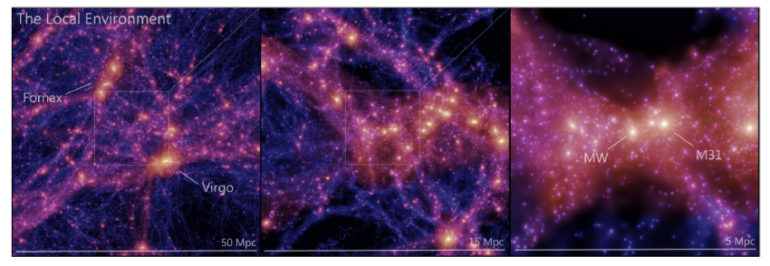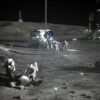Scientists have produced the largest and most accurate virtual representation of the universe to date. An international team of researchers, led by the University of Helsinki, and including members from Durham University, in the U.K., used supercomputer simulations to recreate the entire evolution of the cosmos, from the Big Bang to the present. The findings are published in the Monthly Notices of the Royal Astronomical Society.
The simulation, named SIBELIUS-DARK, is part of the Simulations Beyond the Local universe (SIBELIUS) project, and is the largest and most comprehensive constrained realization simulation to date. The team meticulously compared the virtual universe to a series of observational surveys to find the correct locations and properties for the virtual analogies of the familiar structures.
It was found that our local patch of the universe may be somewhat unusual as the simulation predicted a lower number of galaxies on average due to a local large-scale ‘underdensity’ of matter. While the level of this underdensity is not considered to be a challenge to the standard model of cosmology, it could have consequences for how we interpret information from observed galaxy surveys.
The simulation covers a volume up to a distance of 600 million lightyears from Earth and is represented by over 130 billion simulated particles, requiring many thousands of computers working in tandem over several weeks and producing large amounts of data. The simulation was performed on the DiRAC COSmology MAchine (COSMA) operated by the Institute for Computational Cosmology at Durham University.
These cosmological simulations developed by the team used relevant physics equations to describe how dark matter and cosmic gas evolve throughout the universe’s lifetime. Dark matter is a hypothetical form of matter thought to account for a large amount of all matter in the universe.
First, the dark matter coalesces into small clumps, called haloes, and the surrounding gas is gravitationally attracted towards these clumps, eventually fragmenting into stars to form galaxies. Over time, haloes grow large enough to host galaxies like our own Milky Way.
Over the past 20 years, cosmologists have developed a standard model of cosmology—the cold dark matter model—which can explain much observed astronomical data, including the properties of heat left over from the big bang and the number and spatial distribution of galaxies observed today.
When simulating a virtual cold dark matter universe, most cosmologists follow a typical, or random, patch, one that is similar to our own observed universe, yet only in a statistical sense.
The simulations carried out in this study are different. By using advanced generative algorithms (models how the data was generated in order to categorize a signal), the simulations are conditioned to reproduce our specific patch of universe, thus containing the present day structures in the vicinity of our own galaxy that astronomers have observed over decades.
This means that the familiar structures within our local universe, such as the Virgo, Coma and Perseus clusters of galaxies, the Great Wall and the Local Void—our cosmic habitat—are reproduced in the simulation. At the center of the simulation is perhaps the most important structure, a pair of galaxies, the virtual counterparts of our own Milky Way and our nearby massive neighbor, the Andromeda galaxy.
Professor Carlos Frenk, Ogden Professor of Fundamental Physics at the Institute for Computational Cosmology, at Durham University, said: “It is immensely exciting to see the familiar structures that we know exist around us emerge from a computer calculation. The simulations simply reveal the consequences of the laws of physics acting on the dark matter and cosmic gas throughout the 13.7 billion years that our universe has been around. The fact that we have been able to reproduce these familiar structures provides impressive support for the standard Cold Dark Matter model and tells us that we are on the right track to understand the evolution of the entire universe.”
Dr. Matthieu Schaller from Leiden University added: “This project is truly ground-breaking. These simulations demonstrate that the standard Cold Dark Matter Model can produce all the galaxies we see in our neighborhood. This is a very important test for the model to pass.”
Former Durham PHD student Dr. Stuart McAlpine, postdoctoral researcher at the University of Helsinki, said: “By simulating our universe, as we see it, we are one step closer to understanding the nature of our cosmos. This project provides an important bridge between decades of theory and astronomical observations.”
The international research team will further analyze the simulation created with the hope of providing further stringent tests of the standard model of cosmology.
More information:
Stuart McAlpine et al, SIBELIUS-DARK: a galaxy catalogue of the Local Volume from a constrained realisation simulation, Monthly Notices of the Royal Astronomical Society (2022). DOI: 10.1093/mnras/stac295
Provided by
Royal Astronomical Society
Citation:
Scientists unveil most accurate virtual representation of the universe (2022, February 10)



